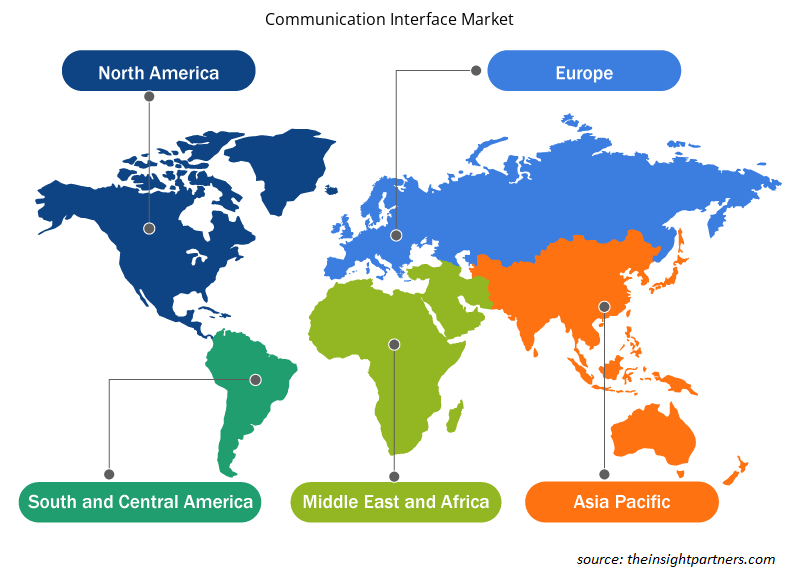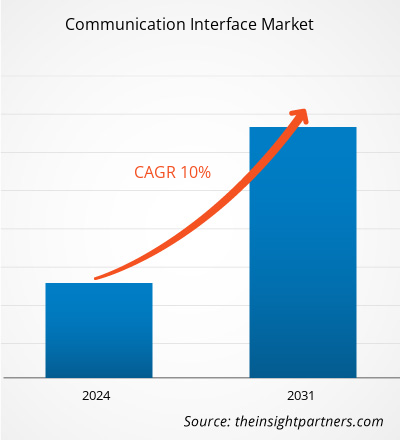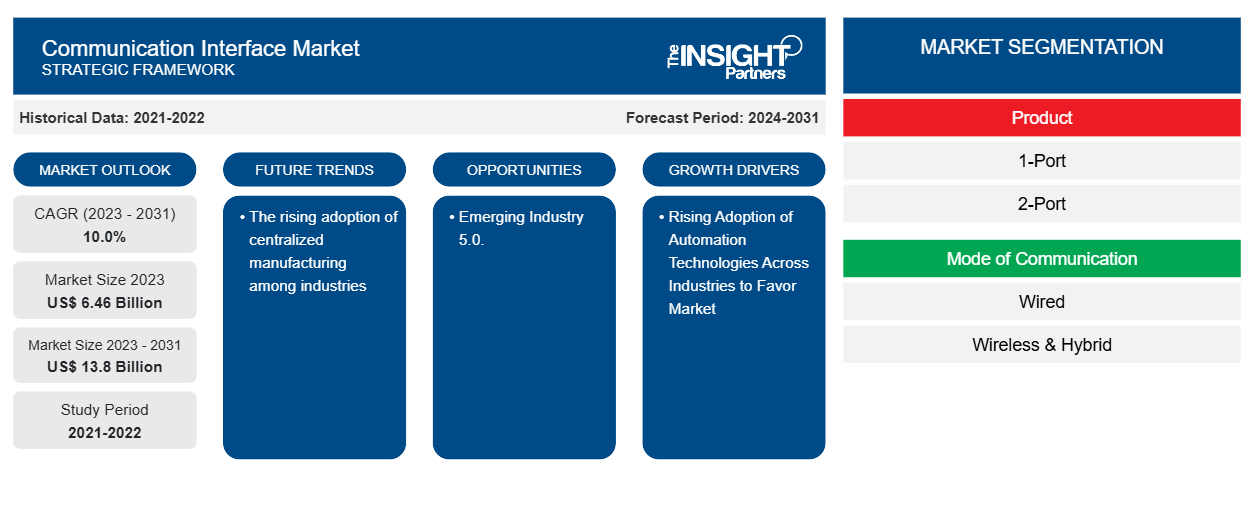Si prevede che la dimensione del mercato dell'interfaccia di comunicazione raggiungerà i 13,8 miliardi di dollari entro il 2031, rispetto ai 6,46 miliardi di dollari del 2023. Si prevede che il mercato registrerà un CAGR del 10,0% nel periodo 2023-2031. La crescente adozione di tecnologie di automazione in tutti i settori e il crescente sviluppo di robot saranno probabilmente i principali driver e trend del mercato dell'interfaccia di comunicazione.
Analisi di mercato dell'interfaccia di comunicazione
Il mercato delle interfacce di comunicazione sta vivendo una crescita significativa a livello globale. Questa crescita è attribuita alla crescente adozione di tecnologie di automazione in tutti i settori e al crescente sviluppo di robot. Inoltre, si prevede che l'emergere dell'Industria 5.0 e la crescente adozione della produzione centralizzata tra i settori guideranno il mercato nei prossimi anni.
Panoramica del mercato dell'interfaccia di comunicazione
Le interfacce di comunicazione sono le interfacce e i protocolli che consentono al software, ai sistemi operativi, alle directory, alle reti, ai sistemi operativi di rete o al software basato sul Web installati su un computer di interagire con il software della piattaforma Microsoft su un altro computer, incluse, senza limitazioni, le comunicazioni progettate per garantire sicurezza, autenticazione o privacy.
Personalizza questo report in base alle tue esigenze
Riceverai la personalizzazione gratuita di qualsiasi report, comprese parti di questo report, o analisi a livello nazionale, pacchetto dati Excel, oltre a usufruire di grandi offerte e sconti per start-up e università
-
Scopri le principali tendenze di mercato in questo rapporto.Questo campione GRATUITO includerà analisi di dati che spaziano dalle tendenze di mercato alle stime e alle previsioni.
Driver e opportunità del mercato dell'interfaccia di comunicazione
Crescente adozione di tecnologie di automazione in tutti i settori per favorire il mercato
La crescente adozione di tecnologie di automazione in tutti i settori sta effettivamente guidando il mercato delle interfacce di comunicazione. Ciò è dovuto a fattori quali la crescente importanza dell'interconnettività. C'è un'elevata necessità di una comunicazione fluida e comoda tra vari sistemi e dispositivi nell'automazione. L'interfaccia di comunicazione consente il trasferimento di dati e la comunicazione tra dispositivi. Le interfacce di comunicazione comuni includono interfacce USB, interfacce HDMI, interfacce VGA, interfacce Ethernet, interfacce di rete wireless , ecc. Queste interfacce possono essere utilizzate per collegare computer, dispositivi esterni, dispositivi di rete, monitor, stampanti, ecc., per realizzare funzioni di trasmissione dati e comunicazione. Man mano che i settori ampliano i loro sforzi di automazione, richiedono un'interfaccia di comunicazione che possa adattarsi facilmente a nuovi requisiti ed espansioni.interconnectivity. There is a high need for seamless and convenient communication between various systems and devices in automation. The communication interface enables data transfer and communication between devices. Common communication interfaces include USB interfaces, HDMI interfaces, VGA interfaces, Ethernet interfaces,
Industria emergente 5.0.
Il termine Industria 5.0 si riferisce alle persone che lavorano insieme a robot e macchine intelligenti. Si tratta di robot che aiutano gli esseri umani a lavorare meglio e più velocemente sfruttando tecnologie avanzate come l'Internet delle cose (IoT) e i big data. Aggiunge un tocco umano personale ai pilastri dell'automazione e dell'efficienza dell'Industria 4.0. L'Industria 5.0 apre la strada al prossimo ciclo di innovazione industriale che si allinea alle piattaforme compatibili con la quarta iterazione e affronta l'importanza della collaborazione tra macchina e uomo, ovvero i robot collaborativi. Le reti di comunicazione svolgono un ruolo fondamentale nel mantenere l'integrazione e l'iperconnettività tra uomo e macchine. Con l'evoluzione dei dispositivi in sistemi di sistemi, come l'integrazione dell'Internet delle cose (IoT) e dei sistemi cyber-fisici (CPS), le caratteristiche delle reti hanno subito cambiamenti significativi.IoT) and big data. It adds a personal human touch to the Industry 4.0 pillars of automation and efficiency. Industry 5.0 paves the way to the next industrial innovation cycle that aligns with the platforms compatible with the fourth iteration and addresses the importance of collaboration between machine and man, i.e., collaborative robots. Communication networks play a pivotal role in maintaining the integration and hyperconnectivity between man and machines. With the evolution of devices into systems of systems, such as the integration of the Internet of Things (IoT) and cyber-physical systems (CPS), the characteristics of networks have undergone significant changes.
Analisi della segmentazione del rapporto di mercato dell'interfaccia di comunicazione
I segmenti chiave che hanno contribuito alla derivazione dell'analisi di mercato dell'interfaccia di comunicazione sono il prodotto, la modalità di comunicazione e l'applicazione.
- In base al prodotto, il mercato delle interfacce di comunicazione è suddiviso in 1 porta, 2 porte e altri. Si prevede che il segmento 1 porta detenga una quota di mercato significativa nel periodo di previsione.
- In base alla modalità di comunicazione, il mercato delle interfacce di comunicazione è suddiviso in cablato (ethernet, USB, RS-232/RS-485 e altri) e wireless e ibrido. Si prevede che il segmento cablato (ethernet, USB, RS-232/RS-485 e altri) deterrà una quota di mercato significativa nel periodo di previsione.ethernet, USB, RS-232/RS-485, and others) and wireless & hybrid. The wired (ethernet, USB, RS-232/RS-485, and others) segment is anticipated to hold a significant market share in the forecast period.
- Per applicazioni, il mercato è segmentato in monitoraggio industriale, sistemi di monitoraggio delle batterie, comunicazione di sensori remoti, sistemi di segnalazione ferroviaria, comunicazione macchina-macchina e altri. Si prevede che il monitoraggio industriale detenga una quota di mercato significativa nel periodo di previsione.
Analisi della quota di mercato dell'interfaccia di comunicazione per area geografica
L'ambito geografico del rapporto sul mercato delle interfacce di comunicazione è suddiviso principalmente in cinque regioni: Nord America, Asia Pacifico, Europa, Medio Oriente e Africa, Sud e Centro America.
Il Nord America ha dominato il mercato delle interfacce di comunicazione. Le tendenze di adozione di tecnologie elevate in vari settori della regione nordamericana hanno alimentato la crescita del mercato delle interfacce di comunicazione. Si prevede che fattori come l'adozione crescente di strumenti digitali e l'elevata spesa tecnologica da parte delle agenzie governative guideranno la crescita del mercato delle interfacce di comunicazione nordamericano. Inoltre, una forte enfasi sulla ricerca e sviluppo nelle economie sviluppate degli Stati Uniti e del Canada sta costringendo gli operatori nordamericani a portare sul mercato soluzioni tecnologicamente avanzate. Inoltre, gli Stati Uniti hanno un gran numero di operatori del mercato delle interfacce di comunicazione che si sono sempre più concentrati sullo sviluppo di soluzioni innovative. Tutti questi fattori contribuiscono alla crescita del mercato delle interfacce di comunicazione nella regione.fuelled the growth of the communication interface market. Factors such as increased adoption of digital tools and high technological spending by government agencies are expected to drive the North American communication interface market growth. Moreover, a strong emphasis on research and development in the developed economies of the US and Canada is forcing the North American players to bring technologically advanced solutions into the market. In addition, the US has a large number of communication interface market players who have been increasingly focusing on developing innovative solutions. All these factors contribute to the region's growth of the communication interface market.
Approfondimenti regionali sul mercato dell'interfaccia di comunicazione
Le tendenze regionali e i fattori che influenzano il mercato delle interfacce di comunicazione durante il periodo di previsione sono stati ampiamente spiegati dagli analisti di Insight Partners. Questa sezione discute anche i segmenti e la geografia del mercato delle interfacce di comunicazione in Nord America, Europa, Asia Pacifico, Medio Oriente e Africa e America meridionale e centrale.

- Ottieni i dati specifici regionali per il mercato dell'interfaccia di comunicazione
Ambito del rapporto di mercato dell'interfaccia di comunicazione
| Attributo del report | Dettagli |
|---|---|
| Dimensioni del mercato nel 2023 | 6,46 miliardi di dollari USA |
| Dimensioni del mercato entro il 2031 | 13,8 miliardi di dollari USA |
| CAGR globale (2023-2031) | 10,0% |
| Dati storici | 2021-2022 |
| Periodo di previsione | 2024-2031 |
| Segmenti coperti |
Per Prodotto
|
| Regioni e Paesi coperti |
America del Nord
|
| Leader di mercato e profili aziendali chiave |
|
Densità degli attori del mercato dell'interfaccia di comunicazione: comprendere il suo impatto sulle dinamiche aziendali
Il mercato del mercato delle interfacce di comunicazione sta crescendo rapidamente, spinto dalla crescente domanda degli utenti finali dovuta a fattori quali l'evoluzione delle preferenze dei consumatori, i progressi tecnologici e una maggiore consapevolezza dei vantaggi del prodotto. Con l'aumento della domanda, le aziende stanno ampliando le loro offerte, innovando per soddisfare le esigenze dei consumatori e capitalizzando sulle tendenze emergenti, il che alimenta ulteriormente la crescita del mercato.
La densità degli operatori di mercato si riferisce alla distribuzione di aziende o società che operano in un particolare mercato o settore. Indica quanti concorrenti (operatori di mercato) sono presenti in un dato spazio di mercato in relazione alle sue dimensioni o al valore di mercato totale.
Le principali aziende che operano nel mercato delle interfacce di comunicazione sono:
- ABB Ltd.
- Eaton Corporation Plc
- Honeywell International Inc
- Omron Corp
- Automazione Rockwell Inc.
- Sistemi di misurazione; Inc.
Disclaimer : le aziende elencate sopra non sono classificate secondo un ordine particolare.

- Ottieni una panoramica dei principali attori del mercato delle interfacce di comunicazione
Notizie di mercato e sviluppi recenti dell'interfaccia di comunicazione
Il mercato delle interfacce di comunicazione viene valutato raccogliendo dati qualitativi e quantitativi dopo la ricerca primaria e secondaria, che include importanti pubblicazioni aziendali, dati associativi e database. Di seguito sono elencati alcuni degli sviluppi nel mercato delle interfacce di comunicazione:
- Siemens lancia LOGO! Communication Interface Module. Con più protocolli di comunicazione, Modbus RTU/TCP, integrazione di app tramite API RESTful e possibilità di accesso al cloud, LOGO! CIM è un vero punto di svolta. LOGO! CIM consente di inviare e ricevere SMS, oltre a trasferire dati dai dispositivi LOGO! 8.3 al cloud AWS. Con il ricevitore GNSS integrato (GPS), la posizione può essere tracciata e trasmessa. (Fonte: sito Web aziendale Siemens, maggio 2023)
- L'India ha lanciato l'Unified Payments Interface (UPI) presso lo storico grande magazzino parigino Galeries Lafayette, dopo il successo del lancio presso l'iconica Torre Eiffel. (Comunicato stampa, luglio 2024)
Copertura e risultati del rapporto sul mercato dell'interfaccia di comunicazione
Il rapporto "Dimensioni e previsioni del mercato dell'interfaccia di comunicazione (2021-2031)" fornisce un'analisi dettagliata del mercato che copre le seguenti aree:
- Dimensioni e previsioni del mercato dell'interfaccia di comunicazione a livello globale, regionale e nazionale per tutti i segmenti di mercato chiave coperti dall'ambito
- Tendenze del mercato dell'interfaccia di comunicazione e dinamiche di mercato come driver, vincoli e opportunità chiave
- Analisi dettagliata delle cinque forze PEST/Porter e SWOT
- Analisi di mercato dell'interfaccia di comunicazione che copre le principali tendenze di mercato, il quadro globale e regionale, i principali attori, le normative e i recenti sviluppi del mercato
- Analisi del panorama industriale e della concorrenza che comprende la concentrazione del mercato, l'analisi delle mappe di calore, i principali attori e gli sviluppi recenti per il mercato delle interfacce di comunicazione.
- Profili aziendali dettagliati
- Analisi storica (2 anni), anno base, previsione (7 anni) con CAGR
- Analisi PEST e SWOT
- Valore/volume delle dimensioni del mercato - Globale, Regionale, Nazionale
- Industria e panorama competitivo
- Set di dati Excel
Report recenti
Testimonianze
Motivo dell'acquisto
- Processo decisionale informato
- Comprensione delle dinamiche di mercato
- Analisi competitiva
- Analisi dei clienti
- Previsioni di mercato
- Mitigazione del rischio
- Pianificazione strategica
- Giustificazione degli investimenti
- Identificazione dei mercati emergenti
- Miglioramento delle strategie di marketing
- Aumento dell'efficienza operativa
- Allineamento alle tendenze normative























 Ottieni un campione gratuito per - Mercato delle interfacce di comunicazione
Ottieni un campione gratuito per - Mercato delle interfacce di comunicazione